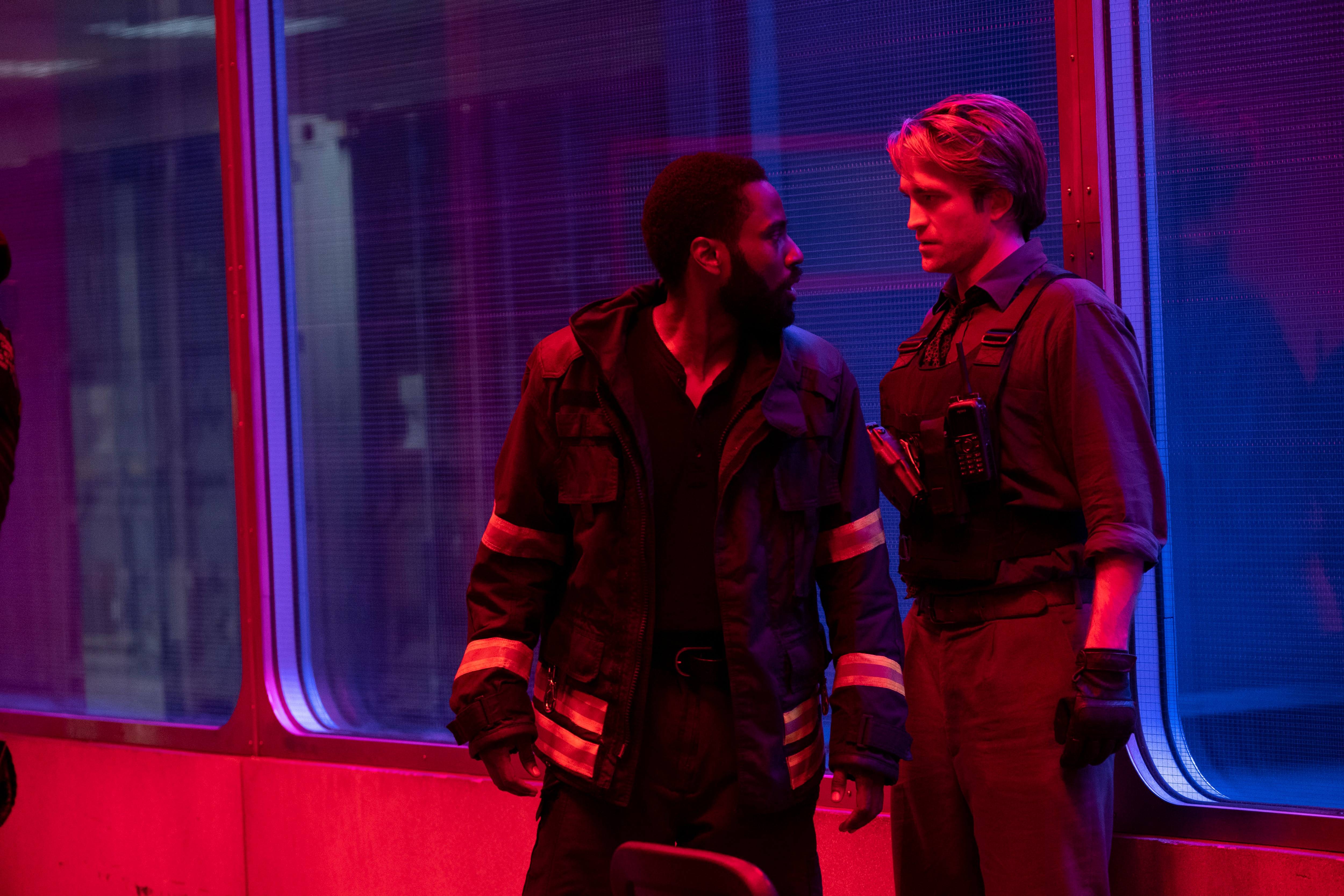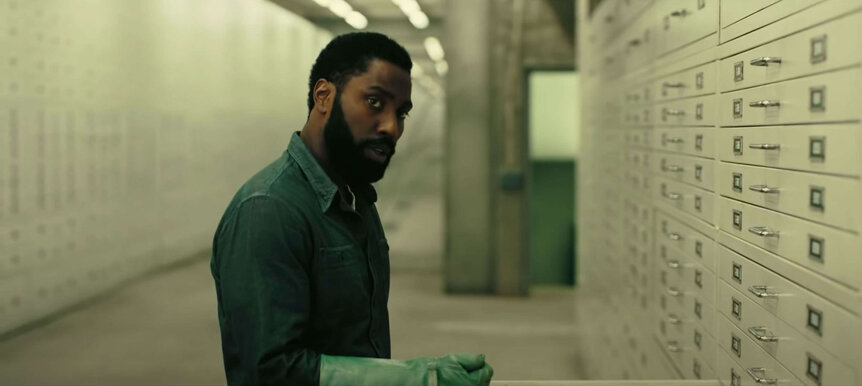Create a free profile to get unlimited access to exclusive videos, sweepstakes, and more!
Costume and a lack of identity in Tenet

Very little was known about Tenet's plot before its delayed release in September. The manipulation of time and space combined with an espionage element were the crumbs of information scattered throughout these snapshots. Even if you have seen the film, you might still be ruminating over the narrative, but the timeless aesthetic was clear from the very first teaser. The tailored suits and fitted knit polo shirts don't reveal much beyond Tenet following in the debonair clothing tradition of other stylish covert movies, including director Christopher Nolan's own dreamscape infiltration Inception.
Reuniting with costume designer Jeffrey Kurland, the pair have previously collaborated on the aforementioned mind-bending sci-fi and the World War II-set Dunkirk. Kurland has other action spy expertise under his belt, having also worked on Mission: Impossible - Fallout. He is no stranger to crafting multiple looks with espionage in mind. Costumes are vital to the visual language of a world while aiding characterization to help create an identity. The vital role clothing plays in the overall scheme drawn up by the Protagonist (John David Washington) also points to some of the narrative failings that occur in this long-awaited science fiction heist.
Spoilers for Tenet ahead.
"You've got the suit, the shoes, the watch. I think you're a little out of your depth," Kat (Elizabeth Debicki) tells the Protagonist early on. This is the second clothing critique the unnamed lead has heard in quick succession, the first of which involves a reminder that the ultra-rich don't shop at Brooks Brothers. Assuming he is on a budget, Michael Crosby (Michael Caine) gives him the green light to go wild with his bespoke wardrobe before emphasizing that the British have a "controlling interest" in the dapper department. Humor isn't entirely absent from Tenet.
This snobby refrain is why the suits shift from perfectly fine to exquisite. Costumes that have seen many reviewers praising the sharp style, even if the movie doesn't meet lofty expectations. "Seek it out, if only to marvel at the entertainingly inane glory of what we once had and are in danger of never having again. Well, that and the suits," The New York Times proclaims.
Before he gets to hit up Savile Row on an all-expenses-paid shopping trip — sadly, not shown — he has spent hanging out in a wind turbine in the middle of the sea. Here is wears a high-vis jacket that will recur later on. "With a hi-vis vest and a clipboard you can get almost anywhere. Almost," the perceptive scientist Barbara (Clémence Poésy) tells the denim-clad interloper before she gives him a lesson in time inversion. He will use this clothing hack later to walk as if invisible through the chaos.
Whether manning a speedboat or strutting down a corridor holding a tiny teacup, John David Washington is impeccably dressed in garments crafted to his measurements. Luxury suits allow him to walk through spaces reserved for the elite. Despite dressing the part, his presence still raises eyebrows due to his race, American accent, and dining partner. He is quick to react to the threat to his safety, turning a cheese grater into an impressive weapon during a kitchen attack. The Protagonist has all the moves of a Bond or Bourne, but we somehow know less about him than the latter when he has no memory.
The revolving costumes don't tell us anything about who he is, because everything he wears is for this very specific work, which reinforces the blank-slate nature of the unnamed character. Any time a personal question is asked, he deflects. The only thing we know is he is American and he is willing to die for his country. He is showcasing his exemplary covert abilities by giving nothing away, and this is what you want from a spy (in the real world). Unfortunately, this distance is detrimental to the overall connection felt between the audience and the story.
The opening sequence — that also played before The Rise of Skywalker's IMAX screenings in December — is set during a siege at the opera. Wearing a tactical uniform, Washington's CIA agent matches other members of the response squad thanks to velcro patches bestowing the correct image. His cover does get blown, but this is the first of many uniforms giving him access to areas that would otherwise be off limits. Garments such as high-vis jackets and utilitarian uniforms act as an invisibility cloak in a world that is heavily under surveillance. Of course, this is not a new concept for a spy to dress as a blue-collar worker to either blend into a secure facility or evade capture by slipping out in the chaos.
Earlier at the airport, the Protagonist and Neil (Robert Pattinson) dress in expensive threads to an exclusive hangar to retrieve a forged Goya drawing. The pair are attacked by masked assailants — later revealed as themselves. Each version of this sequence highlights the vital role clothing plays in Tenet. Juxtapositing the literally faceless uniform in a fight against the flashy suits indicates how easily the Protagonist shifts into whatever outfit is required to complete the mission at hand.
Undertaking a new clothing archetype for each stage of the mission, the ease with which the Protagonist changes into a firefighter's uniform while in a moving car is impressive, as is his ability to use a ladder to secure the package. It isn't usual behavior for a fire engine to be completing these maneuvers while driving at speed, but the trustworthy profession buys them some time. Keeping the protective pants and jacket long after the rest of his cover story has departed, the practical threads are useful in hostile conditions.
In the final sequence, the clothing of war replaces his previous array of job-specific attire he has been cycling through. Army fatigues are another garment that flattens personality, in this case, the squad is split into two — distinct color-coded bands to denote who is part of which team. Visibility is important, but the deindividuation of this character continues. He is everyone and no one.
Kurland's work in Tenet is impeccable, which ensures the costumes are one of the most memorable factors of the film. Unfortunately, the paper-thin development of the spy without a name means it is hard to read his motivations beyond saving the world. Yes, that factor is very important, but the revolving outfits do not add up to much more than a row of empty hangers in his closet.































